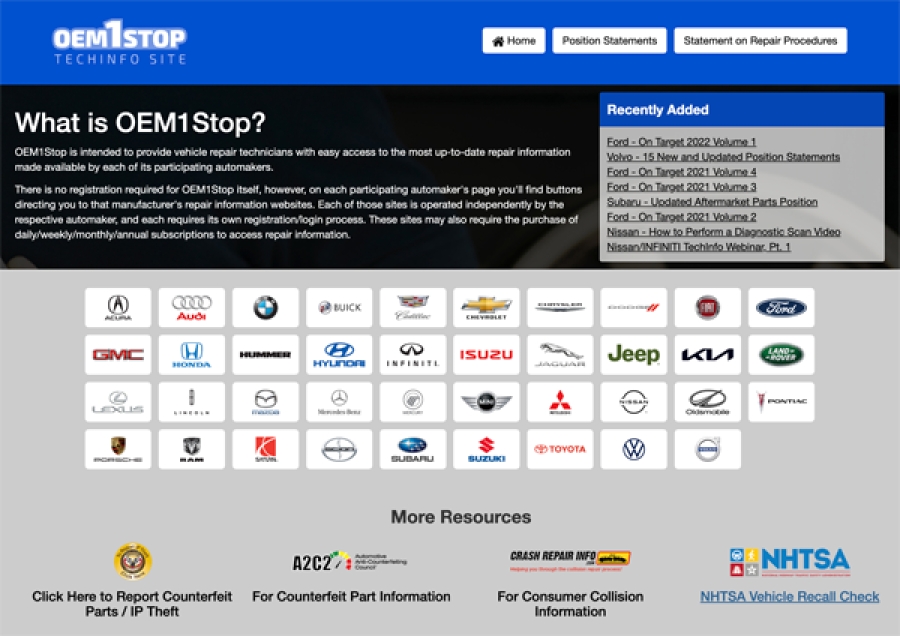Twenty-five years ago, many auto manufacturers found they were experiencing similar non-competitive issues in the industry. George Gilbert from Ford and Rick Sherwood from Campbell & Co. suggested meeting to discuss these issues.
The following year, six exploratory meetings were held with numerous OEMs to find out if it would be helpful to form a more formal group and convene regularly.
In 1999, the OEM Roundtable was formed. Since then, the group has held quarterly meetings alongside the Collision Industry Conference (CIC).

During the April 2022 CIC meeting in Oklahoma City, OK, representatives from the OEM Roundtable shared some of the history and guiding principles of the group. They included, pictured above, left to right,Mark Allen, collision programs and workshop equipment specialist at Audi of America; Dan Ducharme, wholesale parts senior manager for Volkswagen of America; and Devin Wilcox, collision certification manager at Subaru of America.
Currently, 13 major member companies are involved in the OEM Roundtable, including Ford, GM, Honda, Hyundai, Kia, Mazda, Mercedes-Benz, Nissan, Stellantis, Subaru, Toyota, Volkswagen and Volvo. Many of the representatives are active participants in industry organizations and committees as well as events and panel discussions.
Ducharme is the 2022 president of the OEM Roundtable. Prior leaders include:
- 2013–2014: Paul Massie, Ford
- 2015–2016: Gary Ledoux, Honda
- 2017–2019: John Eck, General Motors
- 2020–2021: Rossana Alvarez, Honda
- 2021: Mark Zoba, Nissan
The group’s mission is to continuously improve the quality of collision repair available to vehicle owners.
Allen talked about some of the OEM Roundtable’s frequent topics of discussion, which have included improving access to and use of repair procedures independently developed by some auto manufacturers, bringing awareness to the technician shortage, addressing challenges faced by repairers and parts sellers, as well as researching new industry programs and technologies.
In addition, the group discusses industry programs and legislative and legal updates. Allen said the OEM Roundtable operates under strict anti-trust guidelines.
“We want to help the participants in our programs do better,” said Allen. “By offering support, we hope to build better success quicker for shops.”
Wilcox said some of the guest presenters at the quarterly meetings may include information providers, industry associations, training organizations, service and equipment providers, MSOs, dealers and shop owners, and insurers.
“We’re always open-minded to meeting and discussing what programs and offerings could be beneficial to us as a network and an industry,” he said.
The group adheres to three guiding principles:
- The interests of all parties involved in the collision repair process are best protected when vehicle owners are allowed to make informed decisions regarding collision repairs to their vehicles.
- Active participation by all parties in the collision repair process is necessary if the quality of collision repair available to vehicle owners is to continuously improve.
- Open discussion among those involved in the collision repair process and reliable sources of collision repair data are paramount if the quality of collision repair is to continuously improve.
To support these principles, Allen said OEMs constantly enhance the availability and functionality of repair information developed by each of them.
“The information is there to document the file and repair the car the right way,” he said. “Some of us include what the equipment is that the repair procedures were developed with to get the achievable outcome of repairing the car.”
The OEM Roundtable and its member companies are involved in the industry in many ways. This includes financial supportand engagement with numerous organizations, such as the Automotive Service Association (ASA), Collision Industry Conference (CIC), Collision Industry Electronic Commerce Association (CIECA), Collision Industry Conference (CIF), Collision Repair Education Foundation (CREF), Inter-Industry Conference on Auto Collision Repair (I-CAR), National Auto Body Council (NABC), Society of Collision Repair Specialists (SCRS) and Women’s Industry Network (WIN).
“We want to be available for the industry at these conferences and be accessible,” said Wilcox.
In 2008, the roundtable launched the www.OEM1Stop.com website to respond to the industry’s request for easier access to OEM repair procedures and information. Auto manufacturer position statements were added in 2016. By 2021, there were more than 300,000 total visits to the website and more than 120,000 unique visitors that year alone.
“The number of visits has jumped over 300% since 2016,” said Wilcox. “Many body shops are referencing the site now on a regular basis.”
Another resource available is www.CrashRepairInfo.com, launched in 2014. This website provides direct outreach to customers and guides vehicle owners through the collision repair process with a focus on proper repairs.
Ducharme explained individual OEMs work internally with their engineers to determine what needs to be done pre- and post-collision to streamline repair procedures. At the same time, the group is increasing engagement with body shops and insurance partners.
“We want to make sure everyone has the knowledge and the ability to keep up with all the latest advanced technologies that, as manufacturers, we’re putting into these vehicles,” said Ducharme. “We’re trying to get feedback from all segments so we can make informed decisions and provide a great experience to our mutual customers.”
Looking ahead, the OEM Roundtable hopes to help the industry move forward by increasing collaboration and transparency among all industry segments, providing greater use of tools and continuing to learn from all stakeholders.
“As OEMs, we are here to support the industry and make sure vehicles are being taken care of and repaired properly,” said Wilcox.
“We’re always looking to make it better,” said Allen. “Let’s become professional and agree that we are going to take a look at these repair procedures, have the conversations with customers and insurance partners, and get the car repaired the right way.”










Stacey Phillips Ronak